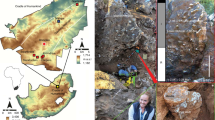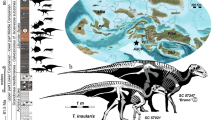Abstract
SOME Miocene hominoids may have been extremely sexually dimorphic for body size, inferred from the apparent dimorphism of dental and gnathic remains1–4. But this has never been demonstrated convincingly for any fossil species because of small sample sizes, uncertainties about the number of species in most fossil samples, and the inability to reliably sex individual specimens. Here we demonstrate a case of extreme dental dimorphism, and presumed body-size dimorphism, in a Miocene hominoid sample in which these limitations have been overcome. Lufengpithecus lufengensis from the late Miocene site of Lufeng, China, was more dimorphic than the most dimorphic living hominoid, the orangutan, and may have been more dimorphic than any living anthropoid.
This is a preview of subscription content, access via your institution
Access options
Subscribe to this journal
Receive 51 print issues and online access
$199.00 per year
only $3.90 per issue
Buy this article
- Purchase on Springer Link
- Instant access to full article PDF
Prices may be subject to local taxes which are calculated during checkout
Similar content being viewed by others
References
Kelley, J. J. hum. Evol. 15, 461–495 (1986).
Kelley, J. & Pilbeam, D. in Comparative Primate Biology, Vol. 1 (eds Swindler, D. R. & Erwin, J.) 361–411 (Liss, New York, 1986).
Pilbeam, D. Am. Anthrop. 88, 295–312 (1986).
Pickford, M. Hum. Evol. 1, 111–148 (1986).
Wu, R., Xu, Q. & Lu, Q. Acta anthrop. Sinica 5, 1–30 (1986).
Xu, Q., Lu, Q., Pan, Y., Zhang, X. & Zheng, L. Kexue Tongbao 9, 544–556 (1978).
Xu, Q. & Lu, Q. Vert. Palasiat. 17, 1–13 (1979).
Wu, R. & Oxnard, C. E. Nature 306, 286–260 (1983).
Wu, R. & Oxnard, C. E. Am. J. Primatol. 5, 303–344 (1983).
Kelley, J. & Etler, D. Am. J. Primatol. 18, 15–34 (1989).
Plavcan, J. M. thesis, Duke Univ. (1990).
Wu, R., Xu, Q. & Lu, Q. Acta anthrop. Sinica 2, 1–10 (1983).
Kay, R. F. Proc. natn. Acad. Sci. U.S.A. 79, 209–212 (1982).
Martin, L. B. thesis, Univ. London (1983).
Oxnard, C. E., Lieberman, S. S. & Gelvin, B. R. Am. J. Primatol. 8, 127–152 (1985).
Swindler, D. R. Dentition of Living Primates (Academic, New York, 1976).
Swindler, D. R., McCoy, H. A. & Hornbeck, P. V. in The Baboon in Medical Research Vol. 2 (ed. Vagtbord, H.) 133–150 (University of Texas Press, Austin, 1967).
Kelley, J. thesis, Yale Univ. (1986).
Shea, B. T. Hum. Evol. 1, 97–110 (1986).
Demment, M. W. Afr. J. Ecol. 21, 219–233 (1983).
Pickford, M. Hum. Evol. 1, 77–90 (1986).
Jarman, P. Biol. Rev. 58, 485–520 (1983).
Kay, R. F., Plavcan, J. M., Glander, K. E. & Wright, P. C. Am. J. phys. Anthrop. 77, 385–397 (1988).
Mahler, P. E. thesis, Univ. Michigan (1973).
Post, D., Goldstein, S. & Melnick, D. Am. J. phys. Anthrop. 49, 533–544 (1978).
Leutenegger, W. & Cheverud, J. Int J. Primatol. 3, 387–402 (1982).
Jungers, W. L. in Size and Scaling in Primate Biology (ed. Jungers, W. L.) 345–382 (Plenum, New York, 1985).
Fleagle, J. G. Primate Adaptation and Evolution (Academic New York, 1988).
Leutenegger, W. Am. J. phys. Anthrop. 35, 91–100 (1971).
Lucas, P. W., Corlett, R. T. & Luke, D. A. Z Morph. Anthrop. 76, 253–276 (1986).
Fleagle, J. G. & Kitahara-Frisch, J. in The Lesser Apes (eds Preuschoft, H., Chivers, D. J., Brockelman, W. Y. & Creel, N.) 192–206 (Edinburgh University Press, 1984).
Pilbeam, D. Bull. Peabody Mus. nat. Hist. 31, 1–185 (1969).
Wood, B. A. & Xu, Q. J. hum. Evol. 20, 291–311 (1991).
Author information
Authors and Affiliations
Rights and permissions
About this article
Cite this article
Kelley, J., Qinghua, X. Extreme sexual dimorphism in a Miocene hominoid. Nature 352, 151–153 (1991). https://doi.org/10.1038/352151a0
Received:
Accepted:
Issue Date:
DOI: https://doi.org/10.1038/352151a0
This article is cited by
-
The Metric Features of Teeth in Female-to-Male Transsexuals
Archives of Sexual Behavior (2009)
-
Tooth Wear Difference Between the Yuanmou Hominoid and Lufengpithecus
International Journal of Primatology (2005)
-
Longgupo: EarlyHomo colonizer or late plioceneLufengpithecus survivor in south China?
Human Evolution (2001)
-
Statistical analyses of metric data of hominoid teeth found in Yuanmou of China
Chinese Science Bulletin (2000)
Comments
By submitting a comment you agree to abide by our Terms and Community Guidelines. If you find something abusive or that does not comply with our terms or guidelines please flag it as inappropriate.



